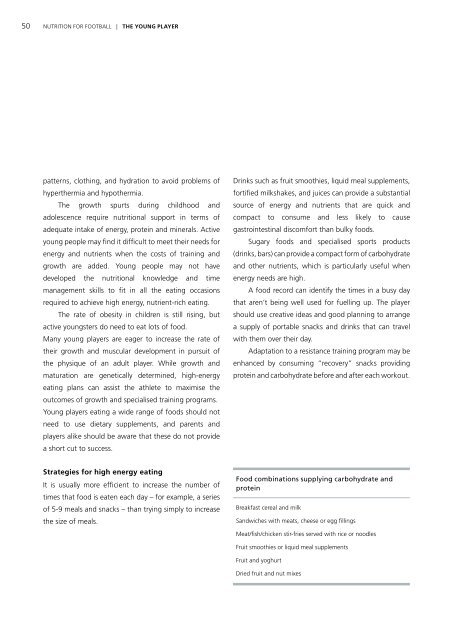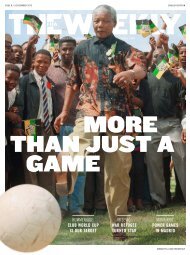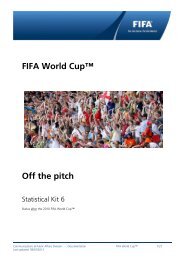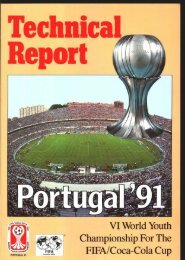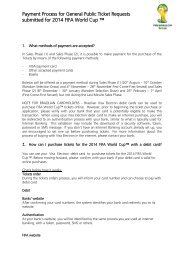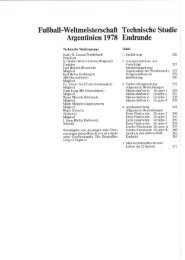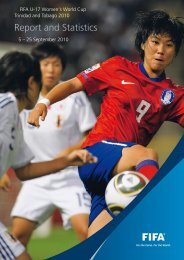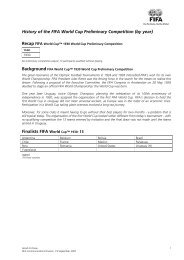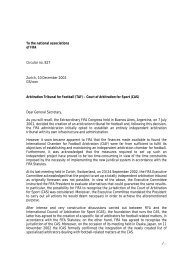Nutrition for football - FIFA.com
Nutrition for football - FIFA.com
Nutrition for football - FIFA.com
Create successful ePaper yourself
Turn your PDF publications into a flip-book with our unique Google optimized e-Paper software.
50 NUTRITION FOR FOOTBALL | thE youNG PlayEr<br />
NUTRITION FOR FOOTBALL | thE rEFErEE 51<br />
patterns, clothing, and hydration to avoid problems of<br />
hyperthermia and hypothermia.<br />
The growth spurts during childhood and<br />
adolescence require nutritional support in terms of<br />
adequate intake of energy, protein and minerals. Active<br />
young people may find it difficult to meet their needs <strong>for</strong><br />
energy and nutrients when the costs of training and<br />
growth are added. Young people may not have<br />
developed the nutritional knowledge and time<br />
management skills to fit in all the eating occasions<br />
required to achieve high energy, nutrient-rich eating.<br />
The rate of obesity in children is still rising, but<br />
active youngsters do need to eat lots of food.<br />
Many young players are eager to increase the rate of<br />
their growth and muscular development in pursuit of<br />
the physique of an adult player. While growth and<br />
maturation are genetically determined, high-energy<br />
eating plans can assist the athlete to maximise the<br />
out<strong>com</strong>es of growth and specialised training programs.<br />
Young players eating a wide range of foods should not<br />
need to use dietary supplements, and parents and<br />
players alike should be aware that these do not provide<br />
a short cut to success.<br />
Strategies <strong>for</strong> high energy eating<br />
It is usually more efficient to increase the number of<br />
times that food is eaten each day – <strong>for</strong> example, a series<br />
of 5-9 meals and snacks – than trying simply to increase<br />
the size of meals.<br />
Drinks such as fruit smoothies, liquid meal supplements,<br />
<strong>for</strong>tified milkshakes, and juices can provide a substantial<br />
source of energy and nutrients that are quick and<br />
<strong>com</strong>pact to consume and less likely to cause<br />
gastrointestinal dis<strong>com</strong><strong>for</strong>t than bulky foods.<br />
Sugary foods and specialised sports products<br />
(drinks, bars) can provide a <strong>com</strong>pact <strong>for</strong>m of carbohydrate<br />
and other nutrients, which is particularly useful when<br />
energy needs are high.<br />
A food record can identify the times in a busy day<br />
that aren’t being well used <strong>for</strong> fuelling up. The player<br />
should use creative ideas and good planning to arrange<br />
a supply of portable snacks and drinks that can travel<br />
with them over their day.<br />
Adaptation to a resistance training program may be<br />
enhanced by consuming “recovery” snacks providing<br />
protein and carbohydrate be<strong>for</strong>e and after each workout.<br />
Food <strong>com</strong>binations supplying carbohydrate and<br />
protein<br />
Breakfast cereal and milk<br />
Sandwiches with meats, cheese or egg fillings<br />
Meat/fish/chicken stir-fries served with rice or noodles<br />
Fruit smoothies or liquid meal supplements<br />
Fruit and yoghurt<br />
Dried fruit and nut mixes<br />
Special needs of the<br />
referees<br />
The referee is frequently the <strong>for</strong>gotten participant in the<br />
match. Much is written about training and nutrition <strong>for</strong><br />
the player, but the referee must also keep up with the<br />
game and needs similar guidance to minimise fatigue.<br />
The players may have someone watching out <strong>for</strong> them<br />
during training and <strong>com</strong>petition, but referees are often<br />
left to themselves to prepare <strong>for</strong> the demands of a<br />
match.<br />
There have been several studies of the volume and<br />
intensity of running by the referee during a match.<br />
Recent data show that the referee runs about as far as<br />
the players, but in a different pattern of movement. For<br />
example, the referee covers more distance going<br />
backwards than do players. Without an appropriate<br />
training program and good nutritional preparation, the<br />
referee may be<strong>com</strong>e fatigued and may not be able to<br />
exert proper control over a match. In particular, referees<br />
should tailor their food and fluid intake prior to and<br />
during a match to the demands of the game. The<br />
demands on the referee’s assistants are less, but each<br />
assistant needs to be prepared to carry the whistle. It is<br />
interesting to note that there is little in<strong>for</strong>mation in the<br />
referee’s training and education regarding adequate<br />
fitness preparation or nutrition <strong>for</strong> per<strong>for</strong>mance.<br />
Thereferee is often older than the players in the match,<br />
and this poses additional stress.<br />
training issues<br />
A team generally trains as a group under the guidance<br />
of a coach or trainer. The referee usually trains alone.<br />
The level of play that the referee is responsible <strong>for</strong><br />
dictates the volume and intensity of training needed.<br />
International referees and referees of high level<br />
professional matches have fitness standards that must


